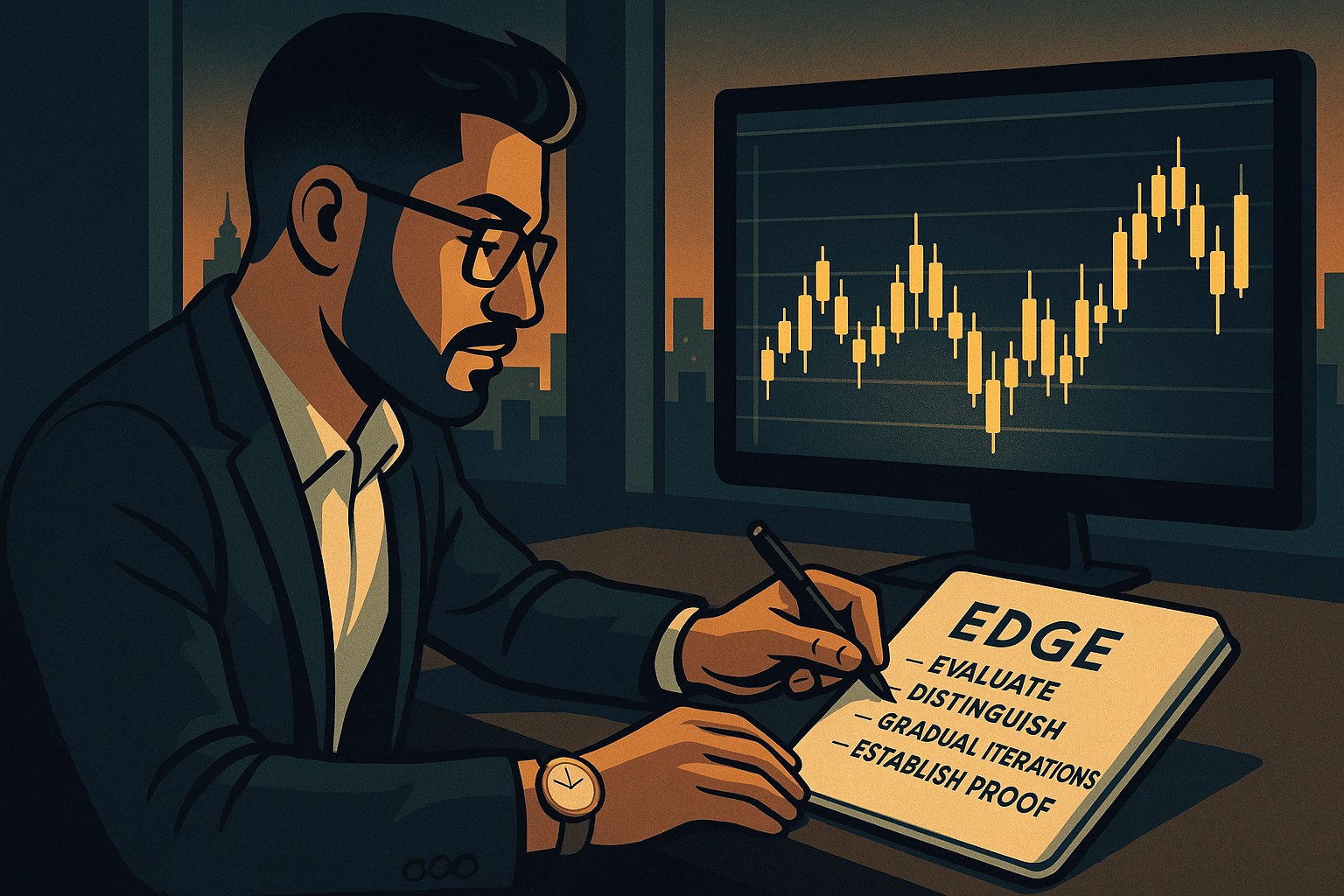The EDGE Framework: Knowing When and How to Evolve as a Trader
2025-09-25 11:56:55
Trading is not about discovering a magic formula that works forever - it’s about building an edge, testing it, and then learning how to refine it over time. Many traders fall into the trap of either never refining their systems at all or constantly changing them with every losing trade. Both extremes are dangerous.

If you’ve read what moves gold, you already know markets are alive and shifting. Gold reacts to interest rates, inflation, risk sentiment, and liquidity. That means your edge cannot stay static forever - but refinement doesn’t mean scrapping your system either. The art is knowing when to refine, what to refine, and how to refine without sabotaging consistency.
This is where the EDGE Framework comes in.
The EDGE Framework: A Trader’s Refinement Process

The word “edge” itself becomes the acronym that guides how and when you refine:
E - Evaluate Performance
Refinement starts with honest evaluation. Too many traders tweak their strategy after three bad trades, but that’s just noise. You need a statistically significant sample size - 20, 30, even 50 trades - before drawing conclusions.
Ask yourself:
• Were losses caused by poor execution (breaking rules)?
• Or did I follow the rules perfectly, but the setup underperformed?
• Did this happen once, or is it repeating over weeks?
If you’re not sure how to pressure-test your process objectively, start with a clean, bias-aware approach to testing using this guide on backtesting without bias. Evaluation is the antidote to emotional overreaction; without it, you risk “fixing” something that isn’t broken.
D - Distinguish Market Conditions
Most edges aren’t “broken” - they’re sensitive to certain conditions. A momentum method that thrives in trending gold markets may bleed during holiday chop. Your job is to tag trades by environment and see where your edge breathes best.
Refinement here means:
• Identifying the environment (trend, range, high-volatility news cycles).
• Tagging trades by conditions in your journal.
• Asking: is my edge condition-specific, or should I add filters?
When trading gold, your condition tags should include macro catalysts (Fed, CPI, NFP), time-of-day, and session. If you’re still mastering gold’s personality, this step-by-step day trading guide for XAU/USD shows how context flows into confirmation.
G - Gradual Iterations
The biggest mistake in refining is changing too much, too fast. Traders often go into “Frankenstein mode” - adding five indicators, three filters, and completely re-engineering entries after one drawdown.
Instead, make small, testable adjustments:
• Adjust stop-loss placement by a few ticks.
• Filter entries by time-of-day.
• Add one confirmation layer (e.g., lower-timeframe sweep or displacement).
Then prove the change. Walk each tweak through a loop of (a) historical checks, (b) paper trading, and (c) tiny live size. For structure on that loop, pair your backtests with deliberate forward testing so you see how the tweak survives the messiness of live conditions.
E - Establish Data-Driven Proof
Refinement is meaningless without proof. You must validate every iteration with:
• Backtesting (multi-month/seasonal samples),
• Forward testing (demo or micro size), and
• A metrics comparison so you know exactly what improved.
If you need a compact scoreboard, use this metrics checklist from Measuring Your Edge - it keeps you focused on expectancy, average R, drawdown, time-in-trade, and strike rate by condition. Only keep changes that improve the right metrics and maintain robustness.
What to Avoid When Refining Your Edge

Traders often sabotage the refinement process. Dodge these traps:
1) Overreacting to short-term losses.
A losing streak doesn’t mean your edge is broken. Every system has drawdowns. If you change rules every time you hit red, you’ll never build long-term confidence.
2) System-hopping disguised as “refinement.”
Switching strategies entirely is not refinement - it’s avoidance. Refining means improving what you already have, not chasing the next shiny method. If you’re tempted to jump, revisit the principles in Refining Your Edge: Iteration Without Overfitting to stay patient and methodical.
3) Over-complicating the playbook.
Cramming in filters until the system almost never triggers is a silent killer. A refined edge should become clearer, not bloated. If you need trend structure, consider a single, simple backbone like the Moving Averages Playbook instead of layering five oscillators.
4) Ignoring context.
You can’t refine in a vacuum. A setup that fails during low-volatility holiday sessions may work beautifully when central banks are active. Tag your trades by context, then iterate where the data says the edge is weak.
5) Refining too often.
Iteration needs dwell time. Refining every week is like a chef changing the recipe before anyone tastes the dish. Let your system “cook” for a defined sample before you judge the tweak.
What to Focus on First (The Main Things)

Execution Consistency
Before changing anything, ask: “Am I following my plan flawlessly?” Most edges fail in the hands, not on the page. If your logs show frequent deviations, fix behavior before blueprint. A simple risk plan from this 2025 risk-management compilation can hard-guard your execution while you gather clean data.
Entry Clarity
Refinements here should be minimal but meaningful - tighter confirmation, clearer displacement, or a specific time-window. If your screenshots show “early stabs” before the real move, codify patience: e.g., “trade only after the first liquidity sweep + break in structure.”
Risk Mechanics
Many edges don’t fail because of signals; they fail because of oversized risk or sloppy stops. A small change to stop placement or to your base R (e.g., from 1.0R to 0.5R during high-impact news windows) can transform expectancy without touching entries. If you’re uncertain, the overview on position sizing and risk will anchor your decisions with clear math.
Context Filters
Instead of adding brand-new setups, refine by defining when not to trade. For gold, this might mean skipping Asian session chop or standing down 15 minutes before/after CPI. If you’re new to mapping these windows, revisit the gold day-trading guide above and align your filter rules with its session insights.
Feedback Loops
The fastest refinement path comes from consistent journaling: screenshots, notes, condition tags, and a short weekly review. Each iteration you test should be traceable to a repeated pattern in your log, not to a hunch you had after one tough day.
Real-Life Analogy: Sharpening a Blade, Not Forging a New One

Think of your edge as a sword. At first, you forge it - it’s rough but functional. With use, it dulls; not because it’s useless, but because friction wears it down. Refinement is the sharpening ritual. You don’t toss the weapon and build a new one every time it dulls. You hone the edges, polish the steel, and make small adjustments until it slices cleaner than before. Likewise, in markets, your ritual is backtest -> forward test -> metric check -> keep or cut. The blade (your edge) stays the same; the sharpness (your rules) improves.
When to Refine (and When Not To)
Refine when:
• You’ve executed 100+ trades with disciplined adherence and see consistent, patterned weaknesses.
• Market regimes evolve (volatility shifts, rate cycles) and your condition tags show performance drift.
• Your journal repeatedly flags the same issue (e.g., early entries after a sweep, poor exits into news spikes).
Don’t refine when:
• You’re simply in a normal drawdown.
• You’ve tested for only 5-10 trades.
• You’re reacting emotionally rather than reviewing data.
If you want a tight “green-to-go” checklist before flipping any switch, pair the backtest guide with the forward testing playbook linked above so you never ship a tweak that hasn’t earned its place.
Final Thoughts

Refinement is not reinvention. It’s small, data-driven adjustments that sharpen your edge without destroying your consistency. The EDGE Framework - Evaluate, Distinguish, Gradual Iterations, Establish Proof - keeps you grounded when emotions push you to overhaul everything.
If you avoid knee-jerk changes, system-hopping, and over-complication - and instead focus on execution, clean risk mechanics, and context filters - your edge will get sharper, more reliable, and more durable over time. When you’re ready to codify risk rules that protect those gains, anchor to a structured plan like the 2025 risk-management compilation. When you need a backbone for trend context, revisit the Moving Averages Playbook. And when your tweak is ready for prime time, run it through both backtesting and forward testing with the measurables that matter.
Your challenge this week: pick exactly one refinement - no more - and run it through the full EDGE loop. Journal the results. If the metrics improve and the edge feels cleaner, you keep the change. If not, you let it go. That’s how you sharpen a blade you can trust.
Start Practicing with Confidence - Risk-Free!
- Trade forex, indices, gold, and more
- Access ACY, MT4, MT5, & Copy Trading Platforms
- Practice with zero risk
It’s time to go from theory to execution - risk-free.
Create an Account. Start Your Free Demo!
Check Out My Contents:
Strategies That You Can Use
Looking for step-by-step approaches you can plug straight into the charts? Start here:
- How To Trade & Scalp Indices at the Open Using Smart Money Concepts (SMC)
- How to Trade Breakouts Effectively in Day Trading with Smart Money Concepts
- Complete Step-by-Step Guide to Day Trading Gold (XAU/USD) with Smart Money Concepts (SMC)
- The Power of Multi-Timeframe Analysis in Smart Money Concepts (SMC)
- Forex Trading Strategy for Beginners
- Mastering Candlestick Pattern Analysis with the SMC Strategy for Day Trading
- How to Use Fibonacci to Set Targets & Stops (Complete Guide)
- RSI Divergence Trading Strategy for Gold: How to Identify and Trade Trend Reversals
- Stochastics Trading Secrets: How to Time Entries in Trending Markets using Stochastics
- Gold Trading Stochastics Strategy: How to Trade Gold with 2R - 3R Targets
- RSI Hidden Divergence Explained: How to Spot Trend Continuations Like a Pro
- Moving Averages Trading Strategy Playbook
- Mastering Fibonacci Trading Psychology - Trusting the Levels, Managing the Mind
- Mastering Price Action at Key Levels - How to Spot, Trade, and Win at the Most Crucial Zones
- Mastering Retests: How to Enter with Confirmation After a Breakout
Indicators / Tools for Trading
Sharpen your edge with proven tools and frameworks:
- The Ultimate Guide to Risk Management in Trading - A Complete Compilation for 2025
- Moving Averages Trading Strategy Playbook
- How to Think Like a Price Action Trader
- Mastering Fibonacci Trading Psychology - Trusting the Levels, Managing the Mind
How To Trade News
News moves markets fast. Learn how to keep pace with SMC-based playbooks:
- Why Smart Money Concepts Work in News-Driven Markets - CPI, NFP, and More
- How to Trade NFP Using Smart Money Concepts (SMC)-A Proven Strategy for Forex Traders
- How to Trade CPI Like Smart Money - A Step-by-Step Guide Using SMC
Learn How to Trade US Indices
From NASDAQ opens to DAX trends, here’s how to approach indices like a pro:
- How to Start Trading Indices and Get into the Stock Market with Low Capital (2025 Guide)
- Best Indices to Trade for Day Traders | NASDAQ, S&P 500, DAX + Best Times to Trade Them
- How To Trade & Scalp Indices at the Open Using Smart Money Concepts (SMC)
- NAS100 - How to Trade the Nasdaq Like a Pro (Smart Money Edition)
How to Start Trading Gold
Gold remains one of the most traded assets - - here’s how to approach it with confidence:
- How to Swing Trade Gold (XAU/USD) Using Smart Money Concepts: A Simple Guide for Traders
- Complete Step-by-Step Guide to Day Trading Gold (XAU/USD) with Smart Money Concepts (SMC)
- The Ultimate Guide to Backtesting and Trading Gold (XAU/USD) Using Smart Money Concepts (SMC)
- Why Gold Remains the Ultimate Security in a Shifting World
- How to Exit & Take Profits in Trading Gold Like a Pro: Using RSI, Range Breakdowns, and MAs as Your Confluence
How to Trade Japanese Candlesticks
Candlesticks are the building blocks of price action. Master the most powerful ones:
- Mastering the Top Japanese Candlesticks: The Top 5 Candlesticks To Trade + Top SMC Candlestick Pattern
- How to Trade Candlestick Patterns with High Probability: A Complete Guide for Beginners
- The Top Japanese Candlestick Guide: What is an Engulfing Pattern and How to Trade It?
- Piercing Pattern Candlestick Explained: How to Trade It - Step-By-Step Guide
- Morning & Evening Star Candlestick Patterns - How to Trade Market Reversals with Confidence
How to Start Day Trading
Ready to go intraday? Here’s how to build consistency step by step:
- 5 Steps to Start Day Trading: A Strategic Guide for Beginners
- 8 Steps How to Start Forex Day Trading in 2025: A Beginner’s Step-by-Step Guide
- 3 Steps to Build a Trading Routine for Consistency and Discipline - Day Trading Edition
- The Ultimate Guide to Understanding Market Trends and Price Action
- Trading with Momentum: The Best Trading Session to Trade Forex, Gold and Indices
Learn how to navigate yourself in times of turmoil
Markets swing between calm and chaos. Learn to read risk-on vs risk-off like a pro:
- How to Identify Risk-On and Risk-Off Market Sentiment: A Complete Trader’s Guide
- How to Trade Risk-On and Risk-Off Sentiment - With Technical Confirmation
- The Ultimate Guide to Understanding Market Trends and Price Action
Want to learn how to trade like the Smart Money?
Step inside the playbook of institutional traders with SMC concepts explained:
- Why Smart Money Concepts Work: The Truth Behind Liquidity and Price Action
- Mastering the Market with Smart Money Concepts: 5 Strategic Approaches
- Understanding Liquidity Sweep: How Smart Money Trades Liquidity Zones in Forex, Gold, US Indices
- The SMC Playbook Series Part 1: What Moves the Markets? Key Drivers Behind Forex, Gold & Stock Indices
- The SMC Playbook Series Part 2: How to Spot Liquidity Pools in Trading-Internal vs External Liquidity Explained
- Fair Value Gaps Explained: How Smart Money Leaves Footprints in the Market
- Accumulation, Manipulation, Distribution: The Hidden Cycle That Runs Every Market
- Institutional Order Flow - Reading the Market Through the Eyes of the Big Players
- London Session Trading Secrets: How Smart Money Sets the High & Low of the Day
- Mastering the New York Session - Smart Money Concepts Guide
Master the World’s Most Popular Forex Pairs
Forex pairs aren’t created equal - - some are stable, some are volatile, others tied to commodities or sessions.
- The Top 5 All-Time Best Forex Pairs to Trade
- Top Forex Pairs Beyond the Big Five
- EUR/USD: The King of Forex
- USD/JPY: The Fast Mover
- GBP/USD: The Volatile Cable
- AUD/USD: The Commodity Currency
- USD/CAD: The Oil-Backed Pair
- GBP/JPY: How to Trade The Beast
- Asian & London Session Secrets
- Mastering the New York Session
Stop Hunting 101
If you’ve ever been stopped out right before the market reverses - - this is why:
- Stop Hunting 101: How Swing Highs and Lows Become Liquidity Traps
- Outsmarting Stop Hunts: The Psychology Behind the Trap
- How to Lessen Risk From Stop Hunts in Trading
- How Stop Hunts Trigger Revenge Trading - Breaking the Pain Cycle
- How to Accept Stop Hunts Without Losing Discipline - Shifting From Frustration to Focus
Trading Psychology
Mindset is the deciding factor between growth and blowups. Explore these essentials:
- The Mental Game of Execution - Debunking the Common Trading Psychology
- Managing Trading Losses: Why You Can Be Wrong and Still Win Big in Trading
- The Hidden Threat in Trading: How Performance Anxiety Sabotages Your Edge
- Why 90% of Retail Traders Fail Even with Profitable Trading Strategies
- Top 10 Habits Profitable Traders Follow Daily to Stay Consistent
- Top 10 Trading Rules of the Most Successful Traders
- Top 10 Ways to Prevent Emotional Trading and Stay Disciplined in the Markets
- Why Most Traders Fail - Trading Psychology & The Hidden Mental Game
- Emotional Awareness in Trading - Naming Your Triggers
- Discipline vs. Impulse in Trading - Step-by Step Guide How to Build Control
- Trading Journal & Reflection - The Trader’s Mirror
- Overcoming FOMO & Revenge Trading in Forex - Why Patience Pays
- Risk of Ruin in Trading - Respect the Math of Survival
- Identity-Based Trading: Become Your Trading System for Consistency
- Trading Psychology: Aligning Emotions with Your System
- Mastering Fear in Trading: Turn Doubt into a Protective Signal
- Mastering Greed in Trading: Turn Ambition into Controlled Growth
- Mastering Boredom in Trading: From Restless Clicking to Patient Precision
- Mastering Doubt in Trading: Building Confidence Through Backtesting and Pattern Recognition
- Mastering Impatience in Trading: Turn Patience Into Profit
- Mastering Frustration in Trading: Turning Losses Into Lessons
- Mastering Hope in Trading: Replacing Denial With Discipline
- When to Quit on Trading - Read This!
- The Math of Compounding in Trading
- Why Daily Wins Matter More Than Big Wins
- Scaling in Trading: When & How to Increase Lot Sizes
- Why Patience in Trading Fuels the Compounding Growth
- Step-by-Step Guide on How to Manage Losses for Compounding Growth
- The Daily Habits of Profitable Traders: Building Your Compounding Routine
- Trading Edge: Definition, Misconceptions & Casino Analogy
- Finding Your Edge: From Chaos to Clarity
- Proving Your Edge: Backtesting Without Bias
- Forward Testing in Trading: How to Prove Your Edge Live
- Measuring Your Edge: Metrics That Matter
- Refining Your Edge: Iteration Without Overfitting
Risk Management
The real edge in trading isn’t strategy - it’s how you protect your capital:
- Mastering Risk Management: Stop Loss, Take Profit, and Position Sizing
- Why Risk Management Is the Only Edge That Lasts
- How Much Should You Risk per Trade? (1%, 2%, or Less?)
- The Ultimate Risk Management Plan for Prop Firm Traders - Updated 2025
- Mastering Position Sizing: Automate or Calculate Your Risk Like a Pro
- Martingale Strategy in Trading: Compounding Power or Double-Edged Sword?
- How to Add to Winners Using Cost Averaging and Martingale Principle with Price Confirmation
Suggested Learning Path
If you’re not sure where to start, follow this roadmap:
- Start with Trading Psychology → Build the mindset first.
- Move into Risk Management → Learn how to protect capital.
- Explore Strategies & Tools → Candlesticks, Fibonacci, MAs, Indicators.
- Apply to Assets → Gold, Indices, Forex sessions.
- Advance to Smart Money Concepts (SMC) → Learn how institutions trade.
- Specialize → Stop Hunts, News Trading, Turmoil Navigation.
This way, you’ll grow from foundation → application → mastery, instead of jumping around randomly.
Follow me for more daily market insights!
Jasper Osita - LinkedIn - FXStreet - YouTube
This content may have been written by a third party. ACY makes no representation or warranty and assumes no liability as to the accuracy or completeness of the information provided, nor any loss arising from any investment based on a recommendation, forecast or other information supplies by any third-party. This content is information only, and does not constitute financial, investment or other advice on which you can rely.
Try These Next
4 Powerful Tactics to Overcome the Most Costly Forex Mistakes
How to Master MT4 & MT5 - Tips and Tricks for Traders
The Importance of Fundamental Analysis in Forex Trading
Forex Leverage Explained: Mastering Forex Leverage in Trading & Controlling Margin
The Importance of Liquidity in Forex: A Beginner's Guide
Close All Metatrader Script: Maximise Your Trading Efficiency and Reduce Stress
Best Currency Pairs To Trade in 2025
Forex Trading Hours: Finding the Best Times to Trade FX
MetaTrader Expert Advisor - The Benefits of Algorithmic Trading and Forex EAs
Top 5 Candlestick Trading Formations Every Trader Must Know















